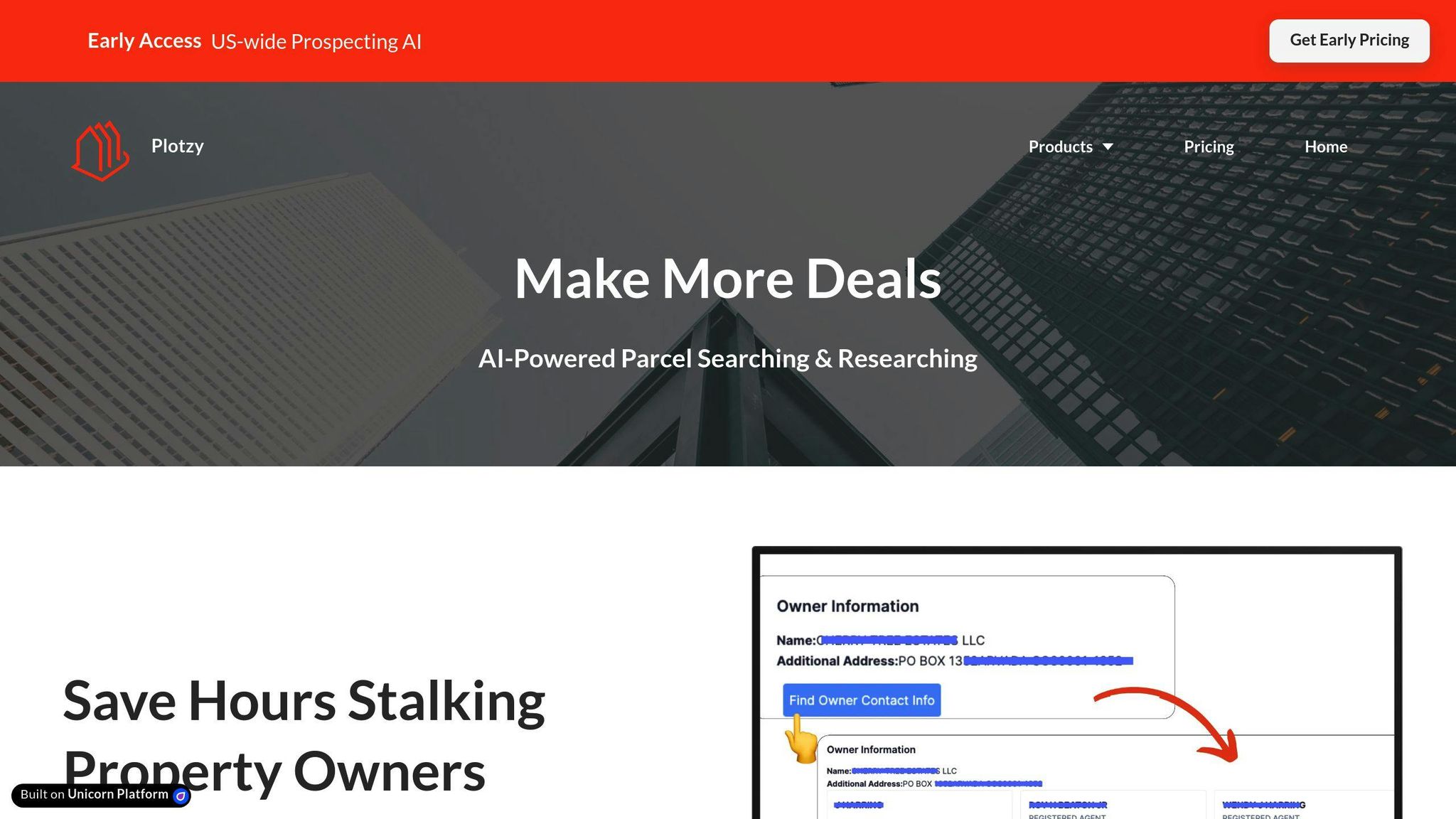Want to pick better business locations using AI? Here's what you need to know in 60 seconds:
| What AI Site Selection Does | Key Benefits |
|---|---|
| Analyzes location data | 2x faster site selection |
| Predicts site performance | 10% higher income |
| Spots market trends | 83% fewer errors |
| Evaluates risks | 60% faster deals |
Key tools you'll use:
| Tool | Cost/Year | Best For |
|---|---|---|
| LandGlide | $100 | Basic property info |
| LandID | $1,000 | Custom mapping |
| Plotzy | $2,400 | Zoning analysis |
| AccuSite | Custom | Traffic patterns |
Quick facts:
- 72% of real estate owners will use AI tools in 2024
- AI checks hundreds of development options for one site
- Teams find good locations in half the time with AI tools
- Wrong locations cost 3x more to fix than to open
This guide shows you how to:
- Collect the right location data
- Use AI tools to analyze sites
- Avoid common mistakes
- Make data-driven location decisions
Want the complete playbook? Keep reading for step-by-step instructions and expert tips.
Related video from YouTube
Basics of Geospatial Data Analysis
Let's break down how location data works and what it can do for your business.
Core Components
Here's what location data analysis looks at:
| Data Class | What It Shows | How Businesses Use It |
|---|---|---|
| Points of Interest | Stores, landmarks | Spot gaps in market coverage |
| Property | Buildings, land lots | Check site conditions |
| Mobility | How people move | Pick high-traffic spots |
| Demographics | Who lives where | Find your customers |
| Environment | Land features | Spot possible problems |
Three Key Data Types
You'll deal with these data formats:
| Type | What It Is | Where You See It |
|---|---|---|
| Vector | Map objects | Street maps |
| Raster | Image grids | Aerial photos |
| Table | Spreadsheet data | Population stats |
Here's what makes this powerful: ATTOM tracks 155 million property boundaries, covering 99% of the U.S. They map 750,000 neighborhoods across 600 metro areas.
AI's Role in Location Analysis
AI turns location data into business decisions. Look at these numbers:
- Downtown Cincinnati: Foot traffic DOWN 59% since 2019
- Texas dominates growth: Owns 9 spots in top 15 fastest-growing U.S. cities
- Buffalo's comeback: Back to 84% of pre-2019 foot traffic
AI spots patterns in:
- When people visit
- How far they'll travel
- Where competitors sit
Pro tip: Mix your business data with outside sources. Combine your sales numbers with market research and government data. This gives you the complete picture for picking your next location.
Tools for Site Analysis
Here's a look at the top AI-powered tools for smarter site selection.
Maps and Charts
These tools help you pick better locations:
| Tool | Price/Year | Key Features | Best For |
|---|---|---|---|
| LandGlide | $100 | - Basic property info - Mobile access - Easy interface |
Small teams starting out |
| LandID | $1,000 | - Custom maps - Team sharing - Map notes |
Mid-size brokers |
| Maptive | Custom | - Google Places data - Real-time updates - Property comparisons |
Large agencies |
| MapRight | Custom | - Mobile version - Sales analysis - Property database |
Field teams |
Here's the thing: Pick a tool that fits your daily work. If you're always on the road, mobile access beats fancy desktop features.
Plotzy

Plotzy makes site selection FAST with these features:
| Feature | What It Does |
|---|---|
| Parcel Search | Find properties by allowed use |
| Zoning Analysis | Get instant zoning answers |
| Owner Info | Access contact details |
| Property Reports | Generate detailed site info |
For $200/month, you get:
- No limits on property searches
- Quick zoning filters
- Owner info at your fingertips
- Fast site decisions
Want to know something cool? Teams with mapping software find good sites in HALF the time.
AccuSite by MapZot.AI takes it up a notch:
- Keeps tabs on 150 million parcels
- Covers almost every U.S. county (98%)
- Shows how people move around
- Connects weather to visitor patterns
Here's what makes AccuSite different: It tracks billions of customer movements to show REAL shopping patterns. This helps you see how new stores might perform in different locations.
4-Step Guide to Location Analysis
Here's how to pick the perfect spot for your business using data (and avoid expensive mistakes).
Getting Your Data Ready
You need 4 types of data to make smart location decisions:
| Data Type | What to Look For | Why It Matters |
|---|---|---|
| Census Data | Population stats, income levels | Shows who lives nearby |
| Traffic Data | Vehicle counts, peak hours | Shows potential customers |
| Market Info | Competitor locations, sales data | Shows market gaps |
| Zoning Laws | Land use rules, building codes | Shows what's possible |
Quick tip: Always check when your data was collected. Old numbers can lead you down the wrong path.
Running the Analysis
Let's break this down into 3 simple steps:
1. Map Your Market
Create a heat map showing:
- Where people live
- How much money they make
- How they move around
- Where your competitors are
2. Score Each Location
| Factor | Points (1-10) | Weight |
|---|---|---|
| Market size | ___ | 30% |
| Access | ___ | 25% |
| Competition | ___ | 25% |
| Zoning fit | ___ | 20% |
3. Look at Travel Times
Here's what a London hospital found:
- People who can drive there in 30 mins: 718,838
- People who can take transit in 30 mins: 311,901
Reading the Results
Here's what your numbers should look like:
| Metric | Good Score | Warning Signs |
|---|---|---|
| Market Coverage | >70% of target | <40% reach |
| Competition | <3 similar sites | >5 nearby |
| Growth Rate | >3% yearly | <1% yearly |
"CARTO helps us analyze hundreds of location factors - from who lives where to where people spend money. This gives us an edge when bidding on properties and helps us move faster." - Data Scientist at American Securities
The numbers don't lie: Businesses that use location data see 4% better returns on high-end commercial spots.
Plotzy's tools can help you:
- See what you can build
- Check zoning rules
- Find property owners
- Make quick reports
Bottom line? You'll pick sites twice as fast and dodge costly mistakes.
sbb-itb-11d231f
AI Methods for Better Site Picks
AI helps pick store locations by crunching numbers and finding patterns humans might miss. Here's how it works:
How AI Learns Patterns
AI looks at what made past locations succeed or fail. It's like having a super-smart assistant that never gets tired of checking data:
| Data Type | What AI Looks For | Impact on Success |
|---|---|---|
| Sales History | Monthly revenue trends | +/- 17% variance |
| Demographics | Population shifts | Market size prediction |
| Traffic Flow | Peak hours, slow times | Customer access |
| Local Economy | Business growth rates | Long-term viability |
The numbers don't lie: 72% of real estate owners now use AI tools for site selection, according to Deloitte's 2024 study.
"AI site selection leverages data-driven insights to streamline the real estate development process." - Andrew Breeding, Senior GIS Programmer at Langan
Future Site Performance
But AI doesn't just look at what's happening NOW. It predicts future success by analyzing:
| Prediction Type | Data Sources | Time Frame |
|---|---|---|
| Market Growth | Building permits, business licenses | 1-3 years |
| Risk Factors | Weather patterns, economic indicators | 5+ years |
| Customer Base | Population trends, income changes | 2-4 years |
Let's look at some real numbers from Kirkland's Home:
- Stores with AI scores above 65/100 make 17% more money
- Most stores score 50/100
- It costs 3x more to close a store than open one
"Generative AI can cycle through ideas and give you different iterations of that idea." - Adam Kent, Design Tech Specialist
Here's what makes AI so good at this job:
- It spots patterns in HUGE amounts of data
- It catches problems before they happen
- It can test hundreds of scenarios in minutes
Bottom line: AI works best when it helps people make smarter choices - not replace them.
Tips and Common Mistakes
Checking Data Quality
Bad data = bad decisions. Here's what you need to check:
| Quality Check | What to Look For | Why It Matters |
|---|---|---|
| Visual Inspection | Points match basemap locations | Wrong locations = wrong sites |
| Alignment Check | Roads and railways line up | Makes or breaks traffic counts |
| Boundary Check | Property lines match reality | Affects what you can build |
| Time Check | Data age and updates | Old data = wrong decisions |
These tools help catch problems FAST:
- ArcGIS Data Reviewer spots errors
- QGIS Topology Checker finds boundary issues
- GeoValidator tests data rules
"Follow these steps to ensure you stay on the path most appropriate for your business." - Svetlana Sicular, Gartner Analyst
Mistakes to Watch For
Here's what goes wrong (and how to fix it):
| Mistake | Problem | Solution |
|---|---|---|
| Old Records | Market data lies to you | Check multiple sources |
| GPS Setup Errors | Points land in wrong spots | Use WGS84, 4+ satellites |
| Server Problems | Geocoding fails | Limit cores to 1/4 locators |
| Missing Data | Miss good sites | Fill gaps with solid sources |
When you're collecting GPS data:
- Use decimal degrees
- Turn on WAAS/DGPS
- Wait for strong signals
Here's what mistakes cost you:
| Error | Money Impact | Time Lost |
|---|---|---|
| Bad Location | 3x more to move | 6-12 months |
| Missing Property Info | +15% purchase price | 2-3 months |
| Wrong Zoning | +40% project time | 4-8 months |
Bottom line: Check your data NOW, not later. Set up quality checks BEFORE you start analyzing.
What's Next in AI Location Analysis
AI site selection is getting faster and smarter. Here's what the data shows:
| Analysis Type | Current Speed | 2024 Projection |
|---|---|---|
| Sales Forecasting | 30 seconds | 5 seconds |
| Market Analysis | 2 hours | 15 minutes |
| Property Evaluation | 4 hours | 45 minutes |
The numbers tell a clear story:
- 72% of real estate owners will invest in AI tools next year
- Companies see a 10% boost in net operating income after using AI
- Analysis time drops by 83%
But that's just the start.
New AI tools are changing the game:
| Tool Type | Function | Impact |
|---|---|---|
| GAN Models | Creates realistic market scenarios | 35% better accuracy |
| Smart Contracts | Automates property deals | Cuts closing time 60% |
| IoT Integration | Tracks building performance | 15% energy savings |
Here's what experts say about these changes:
"AI does not replace the human factor. It's a tool, and right now, you can't rely on just the tool. It's there to augment how you work, not to replace you." - Eric Wittner, Senior Project Manager
Want to see AI in action? Look at The Edge in Amsterdam:
- AI controls lighting and temperature
- Tracks how people use spaces in real-time
- Cuts energy bills by 25%
By 2029, AI in real estate will be a $1335.89 Bn market. These tools keep getting better at:
- Spotting market trends
- Finding good investments
- Picking locations
- Monitoring buildings
What's coming in 2024:
- More AI-IoT connections
- Better energy monitoring
- Smarter space use
- Quick market insights
Wrap-Up
Here's what AI site selection delivers right now:
| Key Area | Impact | Results |
|---|---|---|
| Data Quality | 83% fewer errors | Faster analysis |
| Location Analysis | 72% adoption in 2024 | Better decisions |
| Market Insights | 10% income growth | Smart investments |
| Risk Assessment | 60% faster deals | Fewer mistakes |
The process is simple:
- Start with clean data
- Compare sites with grids
- Mix AI with human know-how
- Stay on top of markets
Want to jump in? Here's your toolkit:
| What to Do | Tool | Why |
|---|---|---|
| Set Up Data | S2/H3 Grids | Quick analysis |
| Study Markets | Map Tools | See patterns |
| Check Risks | AI Systems | Spot problems |
| Track Success | IoT Tech | Watch results |
"AI won't take your job. It's just a tool that makes your work better, not a replacement." - Eric Wittner, Senior Project Manager
Some quick wins:
- Pick your accuracy (10m for cities, 1m for spots)
- Keep data simple to save money
- Check how people move
- Watch where people go
Look at Texas - it's got 9 of the top 15 growing U.S. cities. But California? People are leaving - up 12% since March 2020.
Your AI needs to watch:
- How people move
- Market shifts
- Building types
- Power costs
The bottom line? AI site selection works. Companies pick better spots, faster, with less risk.
FAQs
What is site selection in real estate?
Site selection in real estate uses data to find the best property locations. Here's how it works:
| Component | Purpose | Example |
|---|---|---|
| Data Analysis | Find market gaps | Vestar Capital used location data to bring a brewery to their Northern California shopping center |
| Market Research | Check demand | NY grocers analyze zip code competition |
| AI Tools | Make faster decisions | Zillow spots ready-to-buy customers from website behavior |
| Location Study | Monitor traffic | Shopping centers track how customers move |
In 2018, AI made its first big mark in site selection. An AI system spotted two Philadelphia properties by crunching data - leading to a $26 million deal BEFORE these properties went public.
"Site selection connects business success with market opportunities by putting properties in the right places." - Unacast
Here's what the numbers tell us:
| Metric | Value | Year |
|---|---|---|
| AI Spending | $97.9 billion | 2023 |
| Revenue Boost | 63% of companies | 2023 |
| First AI Deal | $26 million | 2018 |
Site selection looks at:
- How buildings shape up
- What the land offers
- Where markets are heading
- What customers do
- Who else is nearby


